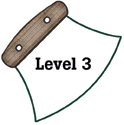|
National Science Education Standards
Energy is a property of many substances and is associated with heat,
light, electricity, mechanical motion, sound, nuclei, and the nature of
a chemical. Energy is transferred in many ways. (Page 155)
Electrical circuits provide a means of transferring electrical energy
when heat, light, sound, and chemical changes are produced. (Page 155)
In most chemical and nuclear reactions, energy is transferred into or
out of a system. Heat, light, mechanical motion, or electricity might
all be involved in such transfers. (Page 155)
The sun is a major source of energy for changes on the Earth’s
surface. The sun loses energy by emitting light. A tiny fraction of that
light reaches the Earth, transferring energy from the sun to the Earth.
The sun’s energy arrives as light with a range of wavelengths, consisting
of visible light, infrared, and ultraviolet radiation. (Page 155)
|
|
Benchmarks
Energy cannot be created or destroyed, but only changed from one form
into another. (Page 85)
Most of what goes on in the universe—from exploding stars and biological
growth to the operation of machines and the motion of people—involves
some form of energy being transformed into another. Energy in the form
of heat is almost always one of the products of an energy transformation.
(Page 85)
Energy appears in different forms. Heat energy is in the disorderly
motion of molecules; chemical energy is in the arrangement of atoms; mechanical
energy is in moving bodies or in elastically distorted shapes; gravitational
energy is in the separation of mutually attracting masses. (Page 85)
|


